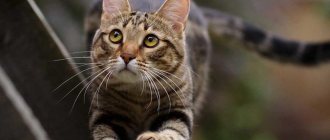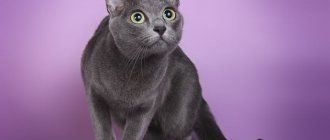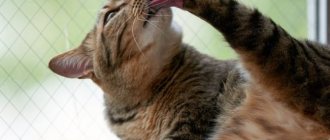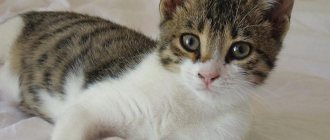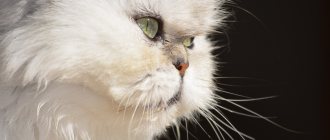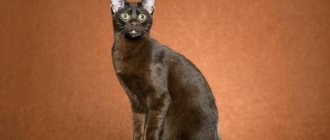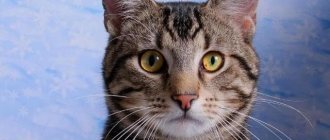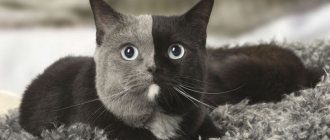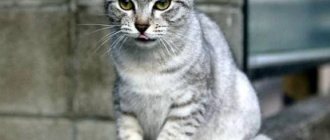Before cats conquered the Internet, they spread throughout the world about 10,000 years ago. Despite such a long period, questions still remain about their existence. Even a child is curious to know what kind of mammal this is - a cat.
They evolved into domesticated pets thanks to several waves of domestication and contributions from Egypt and the Middle East, according to a new study that analyzed the DNA of ancient cats. The analysis shows that, according to biological taxonomy, the domestic cat descends from Felis silvestris lybica.
Who are Felis silvestris lybica cats?
The cat rubs against people and objects
Representatives of the cat family are also owners. It is important for these animals to have their own territory, which they protect from the encroachments of enemies by all available means. Cat owners also consider their owners their property. Cats rub against them or furnishings to secure ownership of them.
Friction is not a meaningless ritual. With its help, pets leave a special smell on friction objects, which, fortunately, the inhabitants of the home do not feel. Where does it come from? There are special scent glands on the cat's body (face, paws, around the eyes). When an animal rubs against something, they become active - and that something begins to smell. Feeling this smell, the cat calms down and feels confident in its abilities and that the enemy will not encroach on its territory.
Description of the Siberian breed
Siberian cats are animals with a well-developed and large body. Adult females weigh up to 6 kilograms, and males are somewhat larger, they can reach 12 kilograms. Siberian cats have a large, well-developed body with muscular legs. A distinctive feature of the breed is the pieces of fur between the toes, inherited from steppe and forest cats. Cat sizes can vary from medium to large.
Siberian cats resemble Persian cats in many ways. Both breeds have a fur collar around the neck and “pants” on the hind legs. The indisputable advantage of the Siberian cat is its fur. But it is not its length that is valued, but the almost complete absence of allergies to it. The coat consists of a hard part and a thick undercoat, which is due to nature itself.
Animal hair is completely waterproof. Therefore, bathing such a pet is a troublesome task. Although the fur of Siberian cats is quite long, it does not require special care. As for colors, through the efforts of breeders, a huge number of variants of various colors have been created, most of which are not found in the natural habitat. Natural colors help animals camouflage in the wild. It is worth noting that natural color is not popular among housewives and cat lovers.
What does scratching mean?
In general, scratching in cats is often regarded as aggressive behavior. But this does not always indicate the bad character of the animal. If the kitten is small, then this is quite acceptable. After all, this is how he understands the world. Yet these “cute creatures” are predators by nature.
But sometimes even adult cats strive to bite or scold their owner. In this case, your pet has a very highly developed hunting instinct . He perceives your moving legs and arms as “prey.” To satisfy the desire of the “hunter”, purchase special toys for him.
Sometimes curtains and furniture suffer from scratching. Cats don't do this out of spite. When scratched on the surface, they remove old nail scales. And they also keep the paw muscles toned. Damaged furniture and curtains are not pampering for them, but a necessity. Therefore, you should think about buying a scratching post.
Life in captivity
Since the wild forest cat is listed in the Red Book, its purchase and sale is illegal. Consequently, in captivity this wild cat can only be found in a zoo or nature reserve.
Conditions of detention
This exotic pet loves space, so it is better to keep it in a small fenced area or by setting up an enclosure. At the same time, you need to remember that the animal jumps 3 meters in length, so it is better to make the fence a little higher. The enclosure must have trees or logs for the pet to climb, as it did in the wild. In a zoo, the conditions for keeping an animal should be the same.
Of course, in a reserve, where an animal feels like in the wild, it lives better than in a zoo.
In captivity, cats reproduce well. Thanks to their maintenance in nature reserves and zoos, the population is preserved.
A forest cat's enclosure should contain trees or logs that it is used to climbing in the wild.
Caring for such a pet is not difficult - it is enough to comb the animal’s fur weekly and bathe it monthly (but this should not be done often). The wild forest cat does not like change, so “his things” do not need to be swapped. These animals are quite strong physically, but they still need to be visited by a veterinarian every six months, who will help eliminate the following diseases characteristic of the breed:
- hypertrophic cardiomyopathy (heart disease);
- polycystic kidney disease;
- retinal dysplasia.
It is not recommended to castrate or sterilize a wild pet, as it does not tolerate anesthesia well.
A friend of mine constantly sends photographs of her wild forest cat, since she lives far away and I have no opportunity to see the animal. A friend says that her pet’s character is not very flexible, but she attributes this feature to the animal’s wild nature. The girl says that, on the contrary, this suits her. A friend of hers bathes her pet quite rarely, and practically doesn’t care about its appearance at all, which is very convenient for her, since she, one might say, “lives” at work. And the cat, although with character, misses her, but lately he has become accustomed to this routine. The main problem is feeding the purr - my friend chose natural food for him, which has to be prepared in advance. Usually this takes up a decent part of the weekend, which, of course, makes the girl indignant. However, according to her, it’s worth it, because a real predator lives next to her. A friend arranged a special house for the animal, reminiscent of a small enclosure. Sometimes she lets the cat out for a walk around the outskirts of her property, but she is very afraid that the wild nature will overpower her love for her owner, and the pet will run away.
Buries food
Burying food is one of the most common habits in cats. Reasons for this behavior:
- Some pets bury food because they like it. This usually happens after changing the usual ready-made food for a new one or after the four-legged pet was offered a self-prepared dish that he had not tried before. Not knowing whether he will have a chance to taste the tasty treat again, the animal tries to hide it so that he can enjoy it again later.
Choosing a kitten
The habits of all cats are generally similar. But how can you find out about the character of an animal if it is a small kitten? How to determine who we choose for ourselves?
There is a theory according to which hormones influence their development. They have an effect on both the body and behavior. Therefore, these two factors are connected, which means that the kitten must be selected based on the expression of its face.
When choosing, you also need to pay attention to your parents. Since kittens are constantly with their mother while growing, they have time to learn basic skills.
Scientists have proven that cats - fathers influence habits and preferences even in the embryonic period. Therefore, if possible, take a closer look at your parents.
The breed plays the biggest role in a cat's character. Therefore, first of all, you need to choose a suitable breed. The period of socialization of a kitten takes place in the first four months. All the skills he can acquire will last a lifetime. Therefore, the owner’s task is to teach his pet everything necessary. And in the end, get maximum positive energy and joy from communicating with this independent creature.
Changes in behavior after spaying and neutering
Character can be different and depends not only on the characteristics described above, but also on upbringing.
The physiological characteristics of cats affect the character of the pet. When animals reach sexual maturity, they want to go for a walk. If they do not get what they want, the behavior does not please the owner. The behavior of a cat in the spring - she constantly meows, scratches the sofa. The cat is also not behaving in the best way. Animal lovers claim that after castration and sterilization, the animal becomes calmer, more balanced, and more affectionate. Stop meowing constantly.
Crushes the owner or upholstered furniture with his paws
Cats mash their owners with their paws because:
- they feel completely safe, just like in childhood, when, as kittens, while feeding, they kneaded their mother’s breasts with their front paws to increase the flow of milk to her nipples;
- they experience true pleasure, and the only way to express gratitude and love to the owner is to sit on his lap and look into his eyes, touching his paws;
- they want to protect a loved one from invisible enemies, leaving odorous marks on him with the help of sweat glands located on the paw pads;
- do therapeutic massage.
These animals crush furniture with their paws to:
- prepare her for bed;
- relieve stress (rhythmic, monotonous movements help them quickly calm down);
- realize sexual instinct during the mating season;
- mark the object of trampling.
Habit of climbing higher
The habit of climbing on high objects (not every cat has this feature) has 2 justifications:
- Felines do this to realize the territorial feeling inherent in nature. These animals adhere to a hierarchical model of relationships. The owner of the territory climbs to a height - this way he can take in all his possessions with his gaze, which allows him to control the situation and, if necessary, descend, subjugating other relatives or entering into battle with them.
- Cats climb to heights because they feel in danger, which comes, for example, from a dog.
Description of the forest cat
The appearance of the animal is very similar to a domestic cat. There are 23 subspecies in total, of which the most common in Russia are the following:
- European forest cat - distinguished by a gray coat with dark lines diverging along the body from the spine;
- Caucasian wild cat - has a brownish color with dark patches throughout the body;
- Far Eastern leopard cat - has gray spots on its reddish skin;
- jungle cat, or swamp lynx - stands out from its fellows with its monochromatic red fur and dark tufts on its ears;
- Amur forest cat - has a thick ocher coat with red-brown spots.
Cats living in desert areas (Africa, Turkmenistan) are usually smaller than others. In addition, they are distinguished by a lighter color. And the inhabitants of the mountains have a thick undercoat and longer hair. The Caucasian cat is often confused with the European forest cat, but this is a larger subspecies (its maximum weight is 11 kg).
Photo gallery of wild forest cat species
The European Forest Cat has a gray coat with dark lines.
The Caucasian wild cat has a brownish color with dark spots
The Far Eastern leopard cat has a reddish coat with gray spots
The jungle cat is also called the marsh lynx
The Amur forest cat has a thick ocher coat
Body structure
The animal’s body length is from 50 cm, and its weight is from 3 to 8 kg. The cat's ears are round-triangular. They are spaced widely, and the animal's tail is short, thick and bushy.
Color and coat
The coat has a yellowish or grayish-brown color, which is always characterized by black stripes or spots. On the outside, the sides and paws are lighter than on the inside. And the belly and inner side of the body have an ocher tint. Some individuals may have white spots on the throat. The animal's tail has black rings of stripes and its tip is black. The animal's fur is uniform and of medium length. Wild seals shed twice a year.
Voice
The animal can whistle, growl and hiss. But sometimes its sounds resemble the hoarse meow of an ordinary cat.
Character
The cat, like all predators, is awake at night. A wild cat begins hunting a couple of hours before sunset and at dawn. The cat overtakes the victim with one jump, which usually reaches three meters in length. If the hunt is unsuccessful, the animal does not pursue the lost prey.
A wild forest cat begins to hunt a couple of hours before sunset
The animal prefers to lead a solitary lifestyle and protects its territory. In places with a large concentration of wild cats, a hierarchy in relationships is maintained. The animal is shy and cautious; it rarely comes close to people and most often does not touch their settlements.
Animals do not like slush and spend cloudy days in shelters, which can serve as:
- heron nests;
- badger and fox holes;
- low tree hollows.
Habitat
Seals live in deciduous and mixed forests (in their remote parts), less often in the mountains (2000–3000 meters above sea level), where animals find refuge in rock crevices. Sometimes they choose shelters from dense tangles of branches, recesses under cliffs. Most of these animals inhabit Central and Western Europe, from which their habitats extend south to Spain. This population can also be found in the Caucasus and Asia Minor.
A wild forest cat can live in mountainous areas
Nutrition
Usually this animal feeds on mammals, which it guards at the entrance to their burrows. Most often these are the following small rodents:
- voles;
- hamsters;
- muskrats.
Predators can also hunt the following representatives of the mustelid genus:
- caresses;
- ferrets;
- ermines.
However, all these animals often fight back against the seals themselves and even pose a serious threat to them. Sometimes wild cats hunt rats and water birds. The predator sits on a tree hanging over the water and jumps onto the back of the prey. Seals tend to guard fish and crayfish near the water, feast on birds from the order Gallinae, especially those nesting on the ground: cats mercilessly destroy their nests, eat eggs and already born chicks.
Forest cats are very fond of squirrels: predators climb the tallest trees after them.
Wild forest cats destroy nests that are on the ground
In rare cases, wounded animals or cubs of larger breeds of the following animals become prey for wild cats:
- roe deer;
- deer;
- chamois
During particularly hungry times, wild forest cats can hunt domestic goats and poultry. There are cases when they entered into battle even with dogs.
At home, it is better to feed the animal the following food:
- dietary raw meat: veal;
- turkey;
- beef;
When using natural food, it is necessary to add vitamin-mineral complexes containing phosphorus and calcium to the animal’s diet, since the large skeleton of this purr needs this. You can also choose ready-made food designed specifically for these pets.
Photo gallery of products recommended for feeding wild forest cats
A wild forest cat needs to regularly eat raw dietary meat
Boiled chicken eggs should be included in the diet of a wild forest cat
Wild forest cat needs to be given sour cream
The diet of a wild forest cat may contain by-products, for example, boiled tongue
Boiled liver can be fed to a wild forest cat at home.
A wild forest cat's diet should include fresh, seedless sea fish.
Reproduction and lifespan
The forest cat is “ready to communicate” only 1–2 times a year during mating. They mark their territory and make calling sounds (similar to those we hear in March in all city yards). At 9–10 months, females are ready to mate. Male cats take a long time to mature: they are ready to have offspring no earlier than two years of age. At the same time, cats leave their usual shelters and gather in groups, chasing the female. Often these animals fight for the possession of the chosen one. She also emits odors that attract males. The strongest of them gets the right to mate with the female.
Before the birth of the cubs, the female sets up a shelter in a rock crevice, a hollow tree or an abandoned burrow of some animal, lining the new “home” with bird feathers and dry grass. The male does not take part in raising children, but there have been cases when cats brought meat to the dens of cats and kittens. When the first litter dies, the female becomes pregnant again.
A wild forest cat usually gives birth to 3–6 kittens
Typically, the offspring of wild forest animals consists of three to six kittens. They feed on mother's milk for up to one and a half months, after which they switch to adult food and begin to hunt on their own. By two to three months they gradually enter adulthood. Wild cats live 10–15 years, domesticated ones - up to 30.
Why do cats hiss when they sense danger?
Many people have repeatedly witnessed “cat fights.” When a cat attacks an enemy, it presses itself to the floor, lowers its ears and emits a terrible hiss. This is explained by the fact that cats are able to imitate and imitate various sounds. Therefore, smart animals chose to imitate a creature that they are practically afraid of - a poisonous snake. The cunning cat's brain understands that hissing is intuitively associated with a snake. That is why, in order to scare the enemy, the cat hisses.
Love for drawers, boxes and cabinets
What does it mean that cats love boxes, drawers and cabinets and have an irresistible desire to hide in them? This feature is explained by the desire for privacy. This habit was passed on to modern pets from their wild ancestors, who were forced to live in harsh conditions, sometimes hiding in secluded places from the predatory animals that hunted them.
In a residential area, cats are not in danger of becoming victims of an enemy, unless we are talking about them living in the same territory with dogs with whom they do not have a good relationship. However, they retained the habit of hiding in secluded places.
Description of the cat: origin and history of domestication
These animals are present on all continents except Antarctica. Although the connection between humans and cats is very old, the latter were domesticated relatively late compared to dogs. One study analyzed the DNA of nearly 200 cats ranging in age from 100 to 9,000 years and found that the population began to spread during the Neolithic period.
Preservation of the gene pool of domestic cats was only possible thanks to the great contribution of the peoples of the Middle East and Egypt, according to a study conducted by the University of Louvain (Belgium). The scientific team collected data on archaeological finds that were discovered in Europe, Africa and Asia from Mesolithic Romania to Angola in the 20th century.
For your information! The findings suggest the existence of two cat lineages that gave rise to the modern domestic cat, descended from the steppe cat (Felis silvestris lybica), a wild subspecies found in North Africa and the Middle East.
They first appeared in Southwest Asia and spread to Europe about 6,400 years ago. According to the scientists' analysis, felines were domesticated by early farmers in the Middle East about 10,000 years ago.
Why did man decide to domesticate the cat?
It was found that the cats domesticated themselves. Unlike all other animals - horses, cows, pigs and even dogs - these animals became domesticated as people became sedentary. Domestication based on mutually beneficial relationships occurred in the first agricultural settlements, where farmers kept these small predators to control the number of rodents. Over time, this behavior led to the domestication of the animal.
Note! Cats spread throughout the Mediterranean and other parts of the world in the first millennium BC through their use as mouse hunters on merchant ships.
However, according to researchers, there is still some uncertainty regarding the origin of Egyptian cats. It is still not clear whether they are descendants of felines brought from the Middle East, or whether a second process of domestication occurred in Egypt. The veneration of cats in ancient Egypt is well known. Papyrus and hieroglyphs show scenes of the daily life of this civilization, and numerous images of this animal can be seen there. In addition, in Egypt the goddess of family and fertility, Bast, who had the head of a cat, was revered.
When did people start breeding cats?
According to many experts, the Egyptian Mau can be considered the oldest cat breed in the world. It is estimated that its ancestors were first bred over 4,000 years ago in Ancient Egypt. The breed began to be improved by the Egyptians themselves, who were responsible for selecting the best individuals to create an optimal representation of the revered feline figure.
For your information! Despite its antiquity, the breed was brought to Europe in 1950 on the initiative of Princess N. Trubetskoy. The Egyptian Mau was quickly adopted as a beloved pet due to its amazing elegance and beauty, as well as its special character.
Common Egyptian Mau cat
Description of the Scottish Straight cat
Scottish cats differ in a number of characteristic features that are unique to this breed. Sometimes animals are often confused with the British species, but during the comparison process the following differences can be identified:
- more rounded head;
- the body has an oblong and elongated shape, which gives the animal elegance;
- body proportions are slightly reduced;
- the average weight of a cat is 3 - 5 kg, boys weigh slightly more than females;
- pets are very flexible and remain hardy and playful at any age.
British cat: description of the breed
The history of the British goes back to the period of Ancient Rome and Egypt. But they already came to Britain, thanks to the Roman legionnaires, during the period when Rome controlled the islands. In this simple way, short-haired cats settled in Britain, where they began to interbreed with forest cats. The animals very quickly became favorites of the British for their aristocratic character and truly refined appearance. It was they who became the ancestors of today's British.
British breed cats are short-haired animals with soft but thick fur. Nature has endowed them with large copper-colored eyes. Cats have a round head and a fairly strong body. Representatives of the breed are characterized by short legs, a broad chest and shoulders, and a plush tail.
Britons can have very different colors: solid, smoke, tortoiseshell, bicolor, tabby. The most common is blue, and therefore even has its own name “British blue”. But other animal colors are not a deviation from the standard.
The British are large to medium in size and have a strong build. The weight of the female is from 3 to 5 kilograms, and the male is 5-7 kilograms.
Places itself to rest in the most inappropriate places (aisles, on the keyboard, etc.)
Pets sometimes disturb the inhabitants of the home, resting in the passages, occupying the space near interior doors and computer keyboards. Is there any special meaning to this behavior? The tendency of cats to settle in inappropriate places can be explained by the desire to mark boundaries.
Representatives of this family consider the territory on which they live, as well as everything that is on it, to be theirs. By being located in doorways, they demonstrate to the inhabitants of the home, including other animals, that it belongs to them. In addition, by staying in the passages, cats try to cool themselves, since it is in such places that air circulates best in the house. They usually behave this way in the warm season or if the home is too hot.
Perhaps this behavior is also due to the fact that the pet, clearly disturbing the inhabitants of the house, is trying to attract attention to itself in such a simple way. Indeed, it’s hard not to notice the cat, which is sitting imposingly on the keyboard. You shouldn't chase him away. It is better to take your four-legged pet in your arms and spend some time with it.
Cat breeds and character
Powerful and proud
Such habits are typical for cats that are close to their wild ancestors. Even after living among people, they do not become completely domestic. They are suitable for a person who works and cannot stay at home all day. They tolerate loneliness and will find something to do in the absence of the owner. Families with small children are better off not getting one, because it is unknown how the pet will react if its tail is pulled or its ears are patted. They do not get along with other animals. Popular breeds with this character are British Shorthair, Persian, Bobtail, Maine Coon.
Sociable and friendly
Siamese, oriental, British cats, sphinxes, German rexes are sociable animals. They can be characterized as “family animals”. They are created for communication. They become attached to people and love to sit in their arms and be petted. Observation shows that such cats more often become members of families with children. They get along well with them. Loneliness is hard to bear. People who don't have enough free time call them clingy. Since they constantly follow the owner’s heels and require attention.
Cheerful and playful
It is recommended to have pets with a playful character if a person has enough time to devote to the animal.
Cat breeds that are characterized by playfulness and an inability to sit in one place are Abyssinians, Siamese, Ocicats, Bengals, Munchkins, and Dwelfs. There are differences in character, behavior and appearance, but everyone is united by a love of adventure. They are bought by active cat lovers, for whom it is not difficult to pay enough attention to the animal. If a person spends a lot of time at work, then such a cat is not for them.
Calm
A cat can be called calm if its nervous system is balanced and stable. This includes purebred American Curls, Siberian cats, Russian Blues, Norwegian Forest cats, Burmese cats, and Burmilla cats. They can be described as obedient, affectionate animals. They are non-aggressive, love their owner, are suitable for small children, and like to be held and petted. But at the same time, they will not bother you and require constant attention. They tolerate loneliness calmly.
Harmful cat habits
Not all cat habits are liked by owners; some habits create difficulties for people keeping a pet in an apartment:
Scratching furniture
Sharpening their claws is a natural need, this is how animals remove excess length and clean off the stratum corneum. It is necessary to install a scratching post and teach the cat to use it, strictly preventing attempts to tear up furniture, wallpaper, carpets, and floor coverings.
Tags
Sexually mature cats leave fragrant business cards on the corners of walls, legs of tables, and cabinets. This is how they indicate their right to territory and declare to females that they are ready to mate.
The acrid smell of the secretion is difficult to evaporate, absorbing into the surface. To avoid an unpleasant spirit in the house, to save yourself from unnecessary suffering, and the animal from illness, attempts to break free, it is recommended to castrate the cat. Especially if the owners do not plan to engage in breeding.
Eating out
Cats walking outside on their own can eat offerings from compassionate passers-by and food waste. Stale food causes poisoning, infectious diseases, indigestion, and vomiting. Particularly dangerous are the linings of “cathunters” stuffed with crushed glass and the points of fishing hooks.
Be sure to read:
How to scare cats away so that they don’t shit, mark and damage furniture, what smell they can’t stand
Utility companies leave out poisonous food to kill rats, but cats can also fall prey to coumarin. It is necessary to feed your pet well before leaving, and it is better to prevent self-walking.
Talkativeness
Intrusive meowing can be irritating for some owners. In this way, the cat signals hunger, fear, anxiety, and pain. Increased talkativeness is unusual for cats; once you figure out the reason, the animal immediately stops talking.
Keeping cats is a fascinating process; intelligent animals adopt the atmosphere of the house and their owners. It's funny to watch them play, fuss with children or other pets, and develop their character as they grow older. Some cat habits have become an inexhaustible source of memes, jokes, and funny videos. Share in the comments which pet habits you like and which you don’t?
Sometimes he curls up into a ball, sometimes he stretches out in his sleep.
Curling up in their sleep is a typical behavior for many cats. It is not difficult to understand why they choose this particular position. Curling up into a ball, tucking their paws under them and wrapping their tail, they just want to keep warm. Animals usually sleep this way in the cold season and when the house is cool.
Another reason for this position in sleep is to protect the internal organs from a possible attack by the enemy. Modern representatives of this family inherited this feature from their wild ancestors, who, even in a sleepy state, were on alert so as not to become prey to predatory animals. Pets are not in danger, but they still sleep curled up in a ball.
Sleeping animals periodically stretch out to stretch their stiff bones. This position indicates that the four-legged pet feels completely safe. Cats sleep in the same position when they are hot.
Features of behavior, when they appear, you need to take your cat to the veterinarian
It is recommended to show your pet to a veterinarian if he:
- Tucks tail to stomach, trembling and spending most of the time lying down. This may indicate the development of diabetes or spinal problems.
- He behaves nervously, constantly licks himself, his tail muscles twitch.
- Constantly snorts and rubs his nose with his paws, which may indicate a runny nose, sinusitis, inflammation of the tooth root, or a foreign body getting into the nasal passages.
- He hides and avoids communication in every possible way or, on the contrary, persistently tries to climb into his arms.
- Shows unmotivated aggression.
- Doesn't allow anyone to touch him.
- Meows constantly.
- He hits the wall with his head, freezing in this position.
- Moves sideways, backs away, crawls away, clinging to the floor.
Share with friends!
